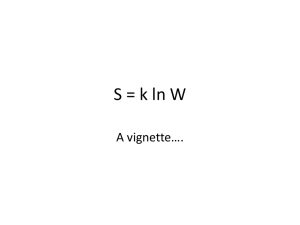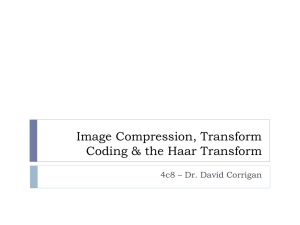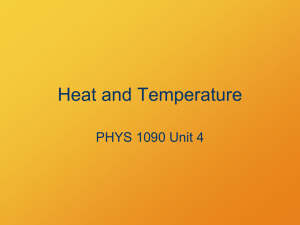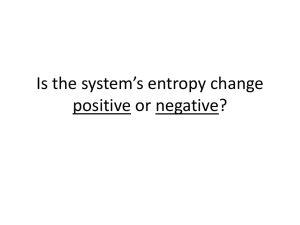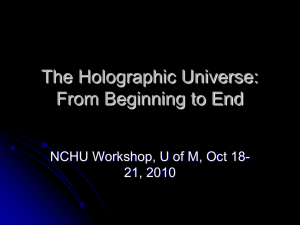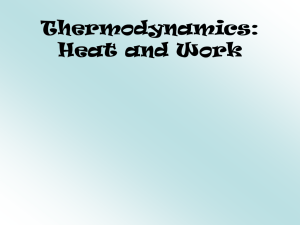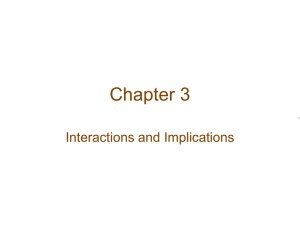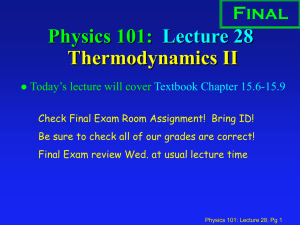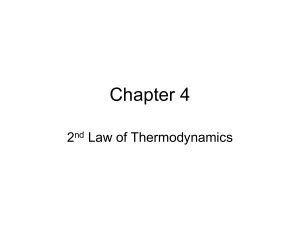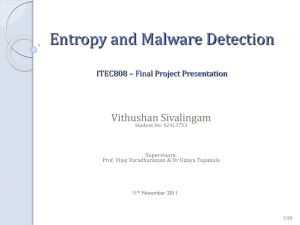4C8
advertisement
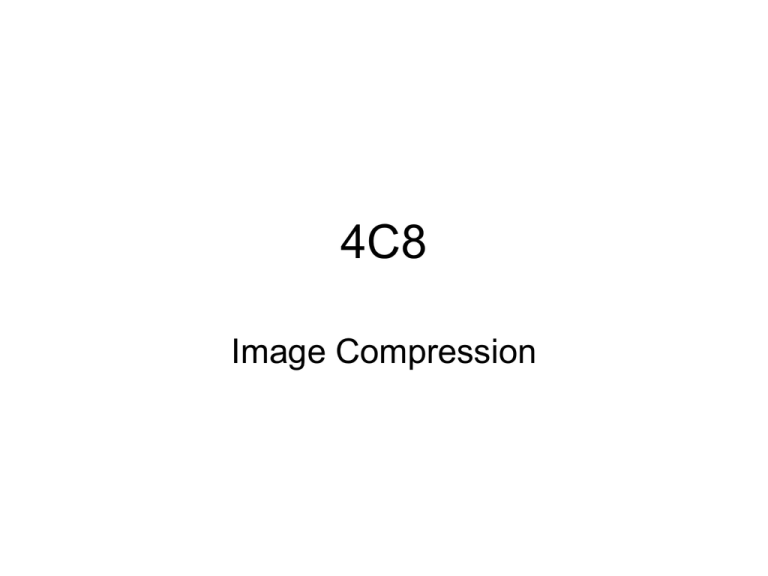
4C8 Image Compression Lossy Compression Effective bit rate = 8 bits/pixel Effective bit rate = 1 bit/pixel (approx) Transform Coding • In the last set of slides we showed that transforming the image into a difference image reduces the entropy of image. G(x,y) = I(x,y) – I(x-1,y) Transform Coding • This is because entropy is greatest when uniform Histogram of the original image Histogram of the difference image Signal Energy Lossy Transform Coding Lossless Lossy Lossless Lossless Energy Compaction with Xforms The Haar Xform LoLo Lo-Hi Hi-Lo Hi-Hi Implementation Details • When calculating the haar transform for the image the mid gray value is typical. • Colour Images are processed by treating each colour channel as separate gray scale images. – If YUV colourspace is used subsampling of the U and V channels is probable. Quantisation • After we create the image we quantise the transform coefficients. • Step size is shown by perceptual evaluation • We can assign different step sizes to the different bands. • We can use different step sizes for the different colour channels. • We will consider a uniform step size, Qstep, for each band for now. Entropy Qstep = 15 Entropy Qstep = 15 • Calculating the overall entropy is trickier – Each coefficient in a band represents 4 pixel locations in the original image. – So bits/pixel = (bits/coefficient)/4 • So the entropy of the transformed and quantised lenna is 4.65 1.15 0.80 1.70 H(X ) 2.07 bits / pel 4 4 4 4 Mistake in Fig. 5 of handout Red Dashed Line is the Histogram. Blue bars represent the “entropies” (ie. - p * log2(p) ) and not vice versa Multilevel Haar Xform Calculating the Entropy for Level 2 of the transform • One Level 1 coefficient represents 4 pixels • One level 2 coefficient represents 16 pixels Level2 Entropies Level1 Entropies Entropy 16 Bands Level 2 Level 1 4 Entropy/Coeff Entropy/pixel LoLo 5.58 0.34 LoHi 2.22 0.14 HiLo 2.99 0.19 HiHi 1.75 0.11 LoHi 1.15 0.29 HiLo 1.70 0.43 HiHi 0.80 0.29 Total Entropy = 1.70 bits/pixel Qstep = 15 Multilevel Haar Xform Calculating the Entropy for Level 3 of the transform • One Level 1 coefficient represents 4 pixels • One level 2 coefficient represents 16 pixels • One level 3 coefficient represents 64 pixels Level3 Entropies Level2 Entropies Level1 Entropies Entropy 64 16 4 Qstep = 15 Calculating the Entropy for Level 3 of the transform • One Level 1 coefficient represents 4 pixels • One level 2 coefficient represents 16 pixels • One Bands level 3 coefficient represents 64 pixels Entropy/Coeff Entropy/pixel Level3 Entropies Level2 Entropies Level1 Entropies LoHi 3.55 0.06 Entropy Level 3 160.07 4 HiLo64 4.52 Level 2 Level 1 LoLo 6.42 0.10 HiHi 3.05 0.05 LoHi 2.22 0.14 HiLo 2.99 0.19 HiHi 1.75 0.11 LoHi 1.15 0.29 HiLo 1.70 0.43 HiHi 0.80 0.29 Total Entropy = 1.62 bits/pixel Qstep = 15 Multilevel Haar Xform Qstep = 15 Measuring Performance • Compression Efficiency - Entropy • Reconstruction Quality – Subjective Analysis Haar Transform Quantisation Quantisation Reconstruction Qstep = 15 Reconstruction Qstep = 30 Reconstruction Qstep = 30 Original Quantised Haar Transform + Quantisation Laplacian Pdfs GOAL – estimate a theoretical value for the entropy of one of the subbands So we can estimate x0 for the band by finding the standard deviation of the coefficient values. x1 = 0, x2 = Q/2 x1 = (k-1/2)Q, x2 = (k-1/2)Q See Handout for Missing Steps Here Measured Entropy is less than what we would expect for a laplacian pdf. This is because the actual decay of the histogram is greater than an exponential decay. Practical Entropy Coding Huffman Coding Practical Results The code is inefficient because level 0 as a probability >>0.5 (0.8 approx) Remember the ideal codelength So if pk = 0.8, then lk log 2( pk ) lk log 2(0.8) 0.32 bits However, the minimum code length we can use for a symbol is 1 bit. Therefore, we need to find a new way of coding level 0 – use run length coding RLC RLC coding to create “events” 13 -5 1 0 0 0 0 0 0 -1 0 0 0 0 0 0 0 0 0 0 0 Define max run of zeros as 8, and we are coding runs of 1, 2, 4 and 8 zeros Here we have 4 non-zero “events” 1 x Run-of-4-Zeros event 2 x Run-of-2 zeros event 1x Run-of-8-zeros event 1 x Run-of-1-zero event Practical Results Synchronisation Say we have a source with symbols A, B and C. Say we wish to encode the message ABBCCBCABAA using the following code table Symbol Code A 0 B 10 C 11 The Coded message is therefore 010101111101101000 Q. What is the decoded message if the 6th bit in the stream is corrupted? Ie. We receive 010100111101101000 Synchronisation • 010100111101101000 Symbol Code A 0 B 10 C 11 • The decoded stream is ABBACCACABA • The problem is that 1 bit error causes subsequent symbols to be decoded incorrectly as well. • The stream is said to have lost synchronisation. • A solution is to periodically insert synchronisation symbols into the stream (eg. One at the start of each row). This limits how far errors can propagate. Summary

